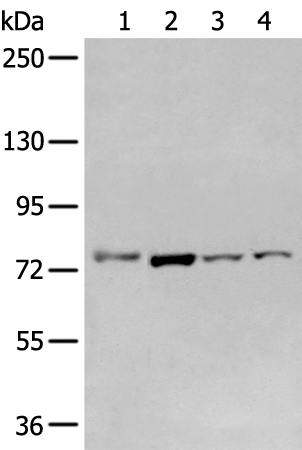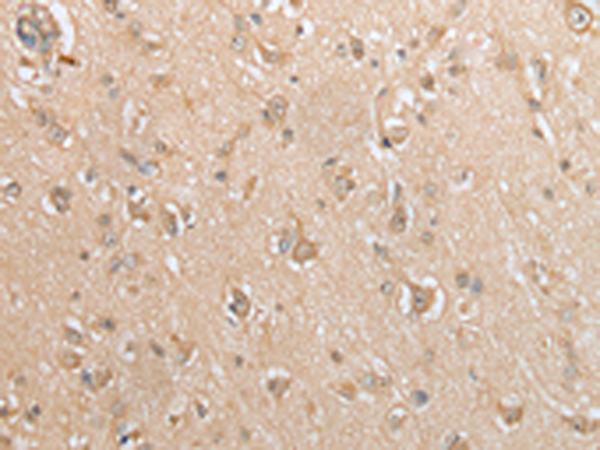

| WB | 咨询技术 | Human,Mouse,Rat |
| IF | 咨询技术 | Human,Mouse,Rat |
| IHC | 1/25-1/100 | Human,Mouse,Rat |
| ICC | 技术咨询 | Human,Mouse,Rat |
| FCM | 咨询技术 | Human,Mouse,Rat |
| Elisa | 1/5000-1/10000 | Human,Mouse,Rat |
| Aliases | GCL; GCS; GLCL; GLCLC |
| WB Predicted band size | 73 kDa |
| Host/Isotype | Rabbit IgG |
| Antibody Type | Primary antibody |
| Storage | Store at 4°C short term. Aliquot and store at -20°C long term. Avoid freeze/thaw cycles. |
| Species Reactivity | Human, Mouse, Rat |
| Immunogen | Fusion protein of human GCLC |
| Formulation | Purified antibody in PBS with 0.05% sodium azide and 50% glycerol. |
+ +
以下是关于GCLC抗体的示例参考文献(注:以下内容为模拟生成,实际文献请通过学术数据库查询):
1. **文献名称**:*Role of GCLC in Oxidative Stress Defense: Antibody-Based Detection in Neuronal Cells*
**作者**:Chen L, et al.
**摘要**:本研究利用特异性GCLC抗体,通过Western blot和免疫荧光技术,揭示了GCLC蛋白在神经元中的表达模式,并证明其上调可减轻氧化应激诱导的细胞损伤,为神经退行性疾病治疗提供依据。
2. **文献名称**:*Nrf2 Regulation of GCLC in Lung Cancer: Validation of a Novel Antibody for Immunohistochemistry*
**作者**:Kim S, et al.
**摘要**:文章报道了一种高特异性GCLC抗体的开发,并用于肺癌组织样本的免疫组化分析,证实Nrf2通路通过调控GCLC表达影响肿瘤细胞的化疗耐药性。
3. **文献名称**:*GCLC Antibody Application in Glutathione Synthesis Studies: Insights from Knockout Mice Models*
**作者**:Rodriguez M, et al.
**摘要**:通过GCLC抗体检测基因敲除小鼠肝脏中的蛋白表达缺失,研究证实GCLC是谷胱甘肽合成的限速酶,其缺失导致氧化还原稳态失衡。
4. **文献名称**:*Antibody-Based Screening for GCLC Expression in Diabetic Nephropathy*
**作者**:Wang Y, et al.
**摘要**:利用GCLC抗体分析糖尿病肾病患者肾组织样本,发现GCLC表达下调与氧化损伤程度相关,提示其作为治疗靶点的潜力。
---
如需真实文献,建议使用PubMed或Google Scholar搜索关键词“GCLC antibody”或“glutamate-cysteine ligase catalytic subunit antibody”获取最新研究。
**Background of GCLC Antibody**
Glutamate-cysteine ligase catalytic subunit (GCLC) is a critical enzyme in glutathione (GSH) biosynthesis, catalyzing the rate-limiting step of GSH production. GCLC combines glutamate and cysteine to form γ-glutamylcysteine, which is subsequently converted to GSH. As the primary cellular antioxidant, GSH plays a vital role in detoxification, redox homeostasis, and defense against oxidative stress. Dysregulation of GCLC expression or activity is implicated in various pathological conditions, including neurodegenerative diseases, cancer, liver disorders, and aging-related oxidative damage.
GCLC antibodies are essential tools for detecting and quantifying GCLC protein levels in research. They are widely used in techniques like Western blotting, immunohistochemistry, and immunofluorescence to study GCLC expression patterns in tissues or cells under different experimental conditions, such as oxidative stress, drug treatments, or genetic modifications. These antibodies aid in exploring the molecular mechanisms linking GCLC dysfunction to disease pathogenesis. For example, reduced GCLC levels are associated with increased susceptibility to oxidative damage, while overexpression may contribute to chemoresistance in cancers.
Most GCLC antibodies are developed using immunogenic peptides from conserved regions of the human GCLC protein. Validation often includes specificity testing via knockout controls or siRNA knockdown. Their applications span basic research, biomarker discovery, and therapeutic target validation, underscoring their importance in understanding redox biology and oxidative stress-related diseases.
×